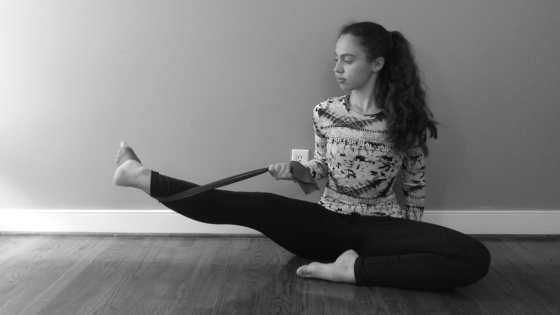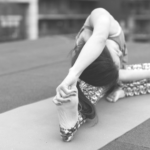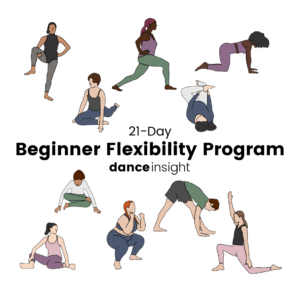
Dance Insight’s original 21-Day Stretching Challenge, published in 2020, was saved on Pinterest over 50,000 times and downloaded over 10,000 times. It was by far our most popular piece of content, yet we’ve decided to retire it and create something entirely new in its place.
Why retire something that’s so popular?
Why fix what isn’t broken?
Well, “isn’t broken” is a matter of opinion.
Our Stretching Challenge Had Some Issues
Though it was created with the utmost care and confidence by a highly qualified dance instructor, our stretching challenge was based on knowledge that is now out-of-date. New research has shown that there are much more effective methods of increasing flexibility than the static stretches suggested in the original 21-Day Stretching Challenge.
1. Static Stretches
Static/passive stretching is when you hold still in a stretched position (i.e. touching your toes).
Dynamic/active stretching is when you simultaneously engage and stretch the same muscle group. For example: holding a runner’s lunge with your hands off the ground. You’re lengthening your hip flexor on the back leg while also engaging those same muscles to stay balanced.
Dance Insight’s 21-Day Stretching Challenge was a series of static stretches only. This is “the old way” of increasing flexibility. If you grew up at a dance studio in the 2010s or earlier, you probably did most of your stretches this way. Maybe you had to hold your splits for a minute, or your teacher came around the room and pushed on everyone’s back during the butterfly stretch. This style of stretching can lengthen your muscles, but it doesn’t build the strength required to use that flexibility in your dancing. Flexibility without strength can also lead to injuries.
There’s nothing wrong with static/passive stretching, but increasing flexibility without also increasing strength won’t help you improve your dancing.
2. Holding Stretches For Too long
Our original stretching challenge suggested holding stretches for up to 60 seconds, which was too intense for a beginner challenge, and frankly unnecessary. This research found that the greatest increase in range of motion occurred when static stretches were held for 15-30 seconds.
I’ve also done my own little experiment since publishing the original stretching challenge. When teaching a ballet class of four 9-10 year olds, I started the school year having them hold their splits for 10 seconds, and increased the length of time each week until they were holding their splits for a minute. After a whole school year of performing this stretch at least twice a week, none of them had more than a minor improvement in their splits. Obviously this isn’t official scientific research, but it really got me wondering whether my methods were effective.
3. Could Be More Thorough
The original stretching challenge started with just two stretches per day, eventually building up to four. Those relatively few stretches were spread out across three areas of focus. In short, there weren’t many stretches for each area of flexibility.
This isn’t an “issue” per se, but it’s definitely an area where we saw room for improvement. We want to provide the most helpful resources possible to our readers, and we thought a great way to do that would be to create a more comprehensive program.
Meet The New Flexibility Program
With those issues in mind, we set out to create the ultimate revision to our 21-Day Stretching Challenge: Dance Insight’s Beginner Flexibility Program. So, what’s new?
New Name
It’s no longer “stretching” because it’s not just stretches anymore, and it’s no longer a “challenge” because flexibility doesn’t happen overnight (or in 21 days), and we don’t want people to think that that’s what we’re promising.
Only Focused On Extensions And Turnout
The original stretching challenge focused on extensions and turnout, with the occasional “extra” thrown in, such as a back or foot stretch. We’ve eliminated the “extras” in the new flexibility program so that we could focus on these two important areas.
Dynamic Stretches And Strengthening Exercises
In Dance Insight’s Beginner Flexibility Program, you’ll find a combination of dynamic stretches, active stretches, passive/static stretches, and strengthening exercises, all designed to help you improve your turnout and extensions.
More Stretches And Exercises Per Day
Another way we’re trying to be more thorough is by including more stretches and exercises in each day of the program. While this will increase the amount of time it takes to complete each day (5-10 minutes estimated), it will also give you a more thorough and effective workout.
Includes Guidance On How To Do Each Exercise Properly
The original stretching challenge was geared specifically towards dancers, and operated under the assumption that the reader knew the proper form for these basic stretches. Now that we’ve seen the wide reach that the original stretching challenge achieved, we’ve realized that we can’t assume our readers have done these stretches before. In the new flexibility program, each exercise is described in detail.
Want in?
Does our new Beginner Flexibility Program sound appealing to you? Good news, you can get it completely FREE right here:
I sincerely hope this new program is helpful to you. Please reach out to danceinsightblog@gmail.com if you have any questions!







